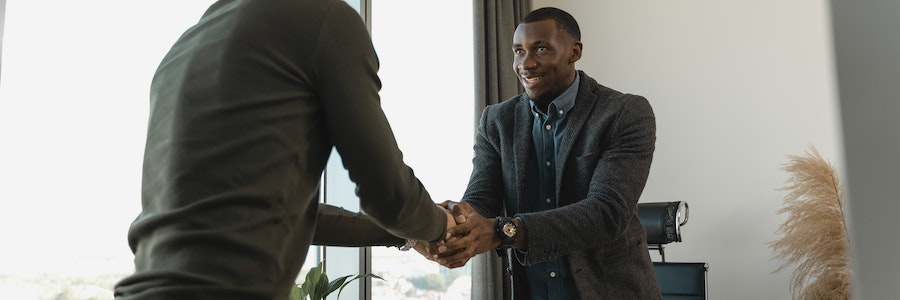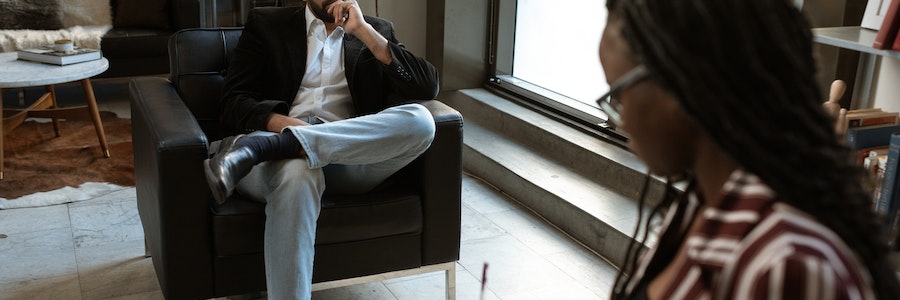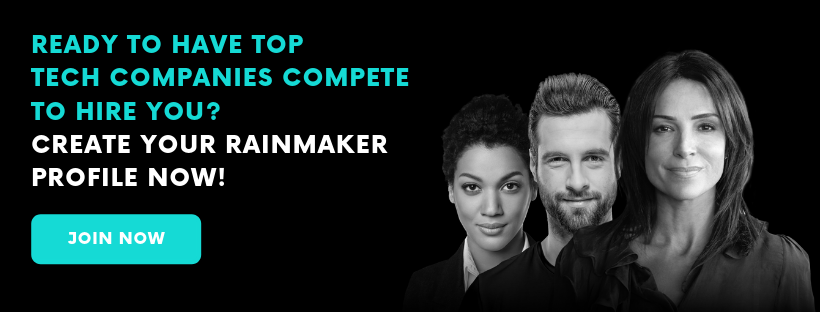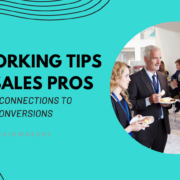How To Ace Your Sales Job Interview With These Effective Body Language Tips
Body Language Tips For Job Interview
We’ve all been there. We were nervously waiting in the lobby for an upcoming interview mulling over what to say, how to say it, and trying to anticipate all the possible questions that would get thrown our way, all so we could try to get one leg up on the other candidates and hopefully land that job!
And that’s great. Those are all important things to think over, but there’s another aspect to the interview that many people probably aren’t considering: body language.
What is body language? Good question.
In essence, it’s the nonverbal communication that occurs between people on a subconscious level. So it goes below the tennis match of spoken words, which is the actual conversation of an interaction.
And let’s be honest, it takes a certain degree of emotional IQ to recognize the body language of others and respond to it accordingly.
Ever heard the phrase, “It’s not what you say, it’s how you say it.”? Well, there’s quite a bit of truth to that.
When it comes to communication, only 7% of what’s being conveyed is actually carried out through spoken words. The remainder comes from body language and tone, which account for 55% and 38% of the overall communication respectively.
Although there is importance to what you say, maybe we’re disproportionately focusing on one aspect of our communication. Perhaps we should instead focus on the other elements that make up most of what makes a great first impression.
Do you want to be 93% more effective in interacting with others? If the answer to that question is yes, then read on.

Tone
As mentioned earlier, tone can account for 38% of what is being communicated subconsciously, and for many people, this actually makes a lot of sense intuitively.
“Sit down.”
In and of itself, this seems like it would be a pretty straightforward statement. You want someone to take a seat. However, depending on the tone taken in making this statement, there can be a great degree of variation in its connotation.
For example, when spoken in a loud, angry, and authoritarian manner, much as a parent might say when reprimanding their child, it is clear that the parent means business. The volume and anger convey to the child that there is an excellent level of disapproval regarding the topic of discussion that is to follow.
Conversely, if that statement is made in a calm and collected fashion, much like a friend might say to another when having them over as guests, it now portrays a sense of welcome and friendliness. Moreover, it’s clear to that friend that what’s to follow should be a delightful conversation which contrasts significantly with our previous example.
As such, you are paying attention to your tone when speaking to someone during your interview is essential. A bit of advice, it’s best to make sure you sound confident and happy, as the recruiter or hiring manager will more likely get a sense that you are serious about this job opportunity and capable of handling the responsibilities that come with it.

Eyes
This can be a challenging aspect of body language to master for the more introverted individuals, but it’s an essential aspect of what makes a great first impression. For example, too little eye contact can portray a lack of confidence or give the other person a sense that you may be hiding something. On the other hand, too much eye contact and you may come off as overly aggressive, which can leave just as bad of an impression on the other end of the spectrum.
Knowing just the right amount of eye contact to maintain during a conversation can be an enigmatic subject for some, but here are some pointers that should make things a little easier.
Use the 50/70 rule.
As a general rule of thumb, when speaking, you should try to maintain eye contact about 50% of the time and 70% when listening. The latter is significant because it conveys a sense of genuine interest to the other person and makes them feel as though you are truly hearing what they’re saying. If you find it difficult to gauge this ratio, another best practice could be to match the other person’s level of eye contact.
Maintain eye contact for about 4-5 seconds at a time.
If you maintain eye contact for a shorter period than prescribed above, you may come across as too nervous or unconfident. On the other hand, maintain eye contact for longer than 5 seconds, and you can verge on the side of coming across as aggressive or even creepy, which may trigger the other person’s fight or flight response and ultimately leave them with a wrong first impression.
Imagine a triangle between the person’s eyes and mouth.
Most people tend to focus on this area of a person’s face in typical business and social interactions. It’s essential to keep this in mind because focusing solely on someone’s pupils might again trigger their fight or flight response. Avoid this by imagining this triangle, as it allows you to maintain “eye contact” without coming across as aggressive or creepy.

Mouth
The mouth can tell how someone feels, which is why we intuitively know that a smile means someone is happy, and a frown means someone is sad. This may seem so simple and obvious, but it’s also possibly why people too easily overlook its importance in a job interview.
Many of us say you should smile when first walking into your job interview.
This is because humans have a natural sense of reciprocity. When an individual sees another smiling, they will mirror that smile. Getting someone to smile will subconsciously get them on the track to enjoying that particular interaction.
What’s less noticeable, and what some people might sometimes miss, are gestures like pursed lips.
If, during a conversation, you happen to catch the other person pursing their lips, even if just for a moment, it would behoove you to take notice. Depending on the context, it may indicate disbelief in what was just said, so it could be an opportunity for you to clarify further, should that be appropriate. In other cases, it may mean the individual disagrees with what is being said and could be your cue to skirt on to another topic quickly.
Suppose you catch the other person placing a finger over their mouth during your discourse. In that case, it’s a sign that the individual is trying to hold back from speaking by blocking their mouth. If appropriate, you may ask for their thoughts or opinions on what was just said so you can clear the air before those hesitations come back to haunt you later in the interviewing process.
Lastly, seeing someone looking intently and biting on something such as the arms of their glasses or a pen means that individual is thinking deeply about themselves. If you notice this gesture, you may not yell out more information to fill the silence. Instead, it may be better to allow them some time to gather their thoughts.
Other gestures that indicate deep thinking are rubbing the chin and placing their fingers on their temples. But, again, be careful because if this gesture is paired with a furrowed brow, it could instead indicate frustration.

Arms
The arms are another telling and, therefore, an essential aspect of body language to pay attention to during the interview.
Crossed arms, for example, are often an indicator that there is some disagreement in the other person’s mind. This is because subconsciously, people cross their arms to put a literal barrier between themselves and the other person there speaking to.
Therefore, if you see this gesture during an interaction, it should be a cue that something is not sitting well with the other person. Of course, there is a bit of context to consider, though, as it can also mean that the other individual may be cold, but in an office setting, this will likely not be the case.
Something else to keep in mind is that during an interview, you’re there to get a sense of the company as much as the hiring manager is trying to get a feel for your fit at their organization. So, suppose during one of your questions, the recruiter or hiring manager starts to cross their arms during their response. In that case, it could mean that there’s something more than what they’re revealing to you directly, as they are literally but subconsciously trying to guard themselves.
Another arm gesture that is worth noting is when the arm is being used as a rest for the head. This is a significant indicator of a person’s boredom. The heavier the head leans on a single arm, the greater the boredom.
Should you find that you are going on at length about a particular response to a question, take note as to whether the other person starts to lean their head against one of their arms, as it should be a cue for you to quickly finish your final thoughts and allow the conversation to continue to other topics. Most typically, this will occur with the arm being further supported by the arms of their chair. However, it’s also possible that it may happen against the table, which would be a more significant indication that you should move on.

Body
Since we’re focusing on body language here, it’s only fitting to touch on the body itself.
Though body posture isn’t quite as revealing as some of the other gestures we’ve covered so far, you can still gather some insights by how someone chooses to orient their body.
For example, when two people are aligned in thought, their body postures will often be aligned. You can see this in action in everyday life. For example, when two friends or lovers might be out for dinner, they may often find themselves mirroring each other’s postures at multiple points during their conversations.
This phenomenon is relatively subconscious and is indicative of the two people’s casual attitudes toward each other. Interestingly enough, though this often happens subconsciously, if used correctly, you can better work toward someone’s favor by mimicking their body posture consciously.
Suppose the interviewer is leaning towards one side more predominantly than the other. In that case, you can slowly, during your conversation, shift your body to trust in a fashion such that you are mirroring them. The same can be said about the positioning of your arms. You could, of course, apply this to your legs as well. Still, in most interview situations, interviewers and candidates sit down, so this particular strategy might not be relevant in all interviewing cases.
One thing to keep note of, though, is that for this strategy to be truly effective, it must be used correctly. So pay special attention to shifting your body posture slowly and naturally with the flow of the conversation because if you copy the other person with every movement they make, not only will you be giving yourself away, but you will come off as insincere, which will ultimately go against the whole purpose of what you’re trying to accomplish.

Summary
Now that you’ve had a chance to read through this article, the next time you walk into an interview, you can step in with a little more confidence knowing that you have the power of body language on your side.
In summary, some of the things you want to be paying attention to are tone, eyes, mouth, arms, and body.
When thinking about tone, try to project a sense of happiness and confidence to demonstrate that you’re eager and capable of the job. Also, pay close attention to the interviewer’s tone when they respond to your comments or questions.
Maintain intense eye contact. If it’s tough to maintain staring at someone’s eyes, imagine a triangle with the eyes and mouths creating the corner to make it a bit easier for yourself. Also, keep eye contact for spurts of 4-5 seconds. Maintaining eye contact for less than that period can show a lack of confidence, and too much longer can come across as over-aggressive or possibly even creepy.
Pay attention to the interviewer’s mouth, as it can give a lot of clues as to how they feel about a particular statement. For example, if they’re smiling after you’ve responded to one of their questions, you’ll know you’re on a good track.
However, pursed lips or a slight frown should be your cue to remedy the situation if possible. Don’t force it, though. Always keep the context of the conversation or situation in mind and follow suit such that it’s a natural progression in the interaction.
Also, look at the person’s arms. Ideally, you want them to be open as it’s a sign that someone is mentally available to what you’re saying. But, on the other hand, be aware of the crossed arms, as that is most likely a sign that they’re not taking well to what is being said.
Lastly, use body posture to your advantage. Though mirroring people’s body posture is most often done subconsciously when they find each other agreeable, you can still use the phenomenon to your advantage in a conscious manner. Just be careful not to overdo it, as you don’t want to shoot yourself in the foot by making it evident that you’re simply trying to mirror them. Do this by transitioning your body slowly and at a natural pace to your conversation.
Now go out there and use these powers of body language to ace your following job interview. Good luck! If you need help connecting with employers, create a profile on Rainmakers!










